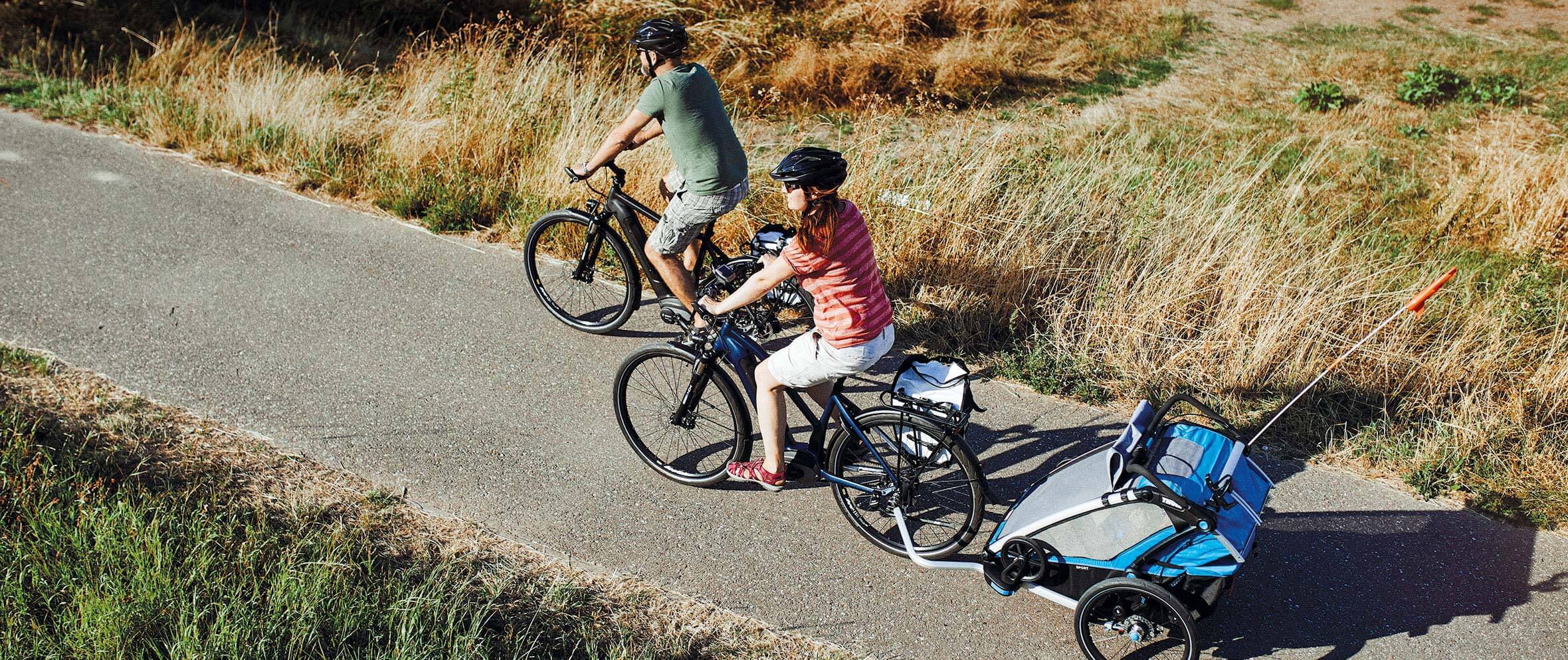Cycling with children
Planning Tips
)
Can you barely wait to finally get your offspring interested in cycling? What about a bike riding tour with your kid? The good news: Cycling tours are easy to plan, even with very young children. Thanks to bike trailers and tandem poles, your small ones can either be comfortable transported for the entire trip or switch over when they’re exhausted. Of course, that doesn’t mean it is a good idea to take beginners on a gruelling 2-week tour through the alps.
But a multi-day trip over light terrain can be fun for the kiddies and will spark their ambitions. Here are a few tips for when you’re planning.
Equipment perfect for little mountain bikers!
Children generally need the same gear as adults - especially when they are riding on their own. A high-quality helmet, functional clothing, and naturally, a bike that is suitable for the type of route you’re planning - all this is essential for young riders. Ideally, all bicycles should get a full check-up before a longer tour.
Any child in a trailer should definitely also wear a helmet, as it can also be injured if there is an accident. Also pay attention to sufficient sun protection for sensitive children’s skin. Clothes for rainy weather and a warm change of clothes certainly need to be packed. Also make sure you have enough fluids and healthy, energy-rich snacks.
Young children: The journey is the destination
Especially for young children that can not ride on their own yet, an exciting route is really important. If small family members are sitting too long in the trailer, they will quickly get bored and start fidgeting or fussing. Plan your route in short stages and check that there are interesting options for the breaks. That could be like a restaurant and petting zoo or a nice playground.
Staying safe with a trailer: short stages, less traffic, flat paths
Make sure that your little ones are thoroughly tired out. It’s best to stimulate them during the breaks with active games like catch or hide-and-seek. And for that first bike our with your child, you should choose a route that you already know well or one with good signposts, so that navigation breaks don’t unnecessarily lengthen the journey. A GPS device for your bike will help.
Also, don’t forget that you’ll need to pull the full weight of your children and trailer up every incline. This can be an unexpected challenge even for the practiced solo cyclist. So be sure to factor in your own physical condition when planning the route. Best to choose a flat and well-constructed route with little traffic.
Kindergarten-aged children: fit for up to 20 kilometres
At this age, children can already handle day trips of up to 20 kilometres. Naturally, this differs from child to child. If your kid is already comfortable on everyday stretches, then you can trust them with a multi-day tour with short daily stretches.
Still, you should definitely take a bike trailer with you, in case your little cyclist gets tired before the day’s destination is reached. A tandem pole with which you can connect the child’s bike with your own, is also a good option.
Bike tours children at primary school age: Fun challenges
Children at this age generally have lots of fun with the challenge of a cycling tour. Ideally, you should also choose an interesting destination, to boost motivation - such as the grandparents’ house, an amusement park, or vacation home at the swimming lake. A day trip of 20 to 50 kilometres is normally doable for even untrained primary school children.
And children are especially happy with the fast effects of training: After just one or two days they’ll notice that inclines are easier to handle and they are less tired in the evening. So adjust the first days to have shorter stages and incrementally lengthen them throughout the tour.
Measure success and plan some challenges
Children love to measure their success - and brag about it afterwards. So it can be a great motivation to document the kilometres cycled and also the elevation gain, with a bicycle app for example. When planning the route, combine flat stretches with light mountain stages. That way you can challenge your child and give it something to be proud of afterwards - a real boost for a child’s self-esteem.
Safety is the first priority
It is important to challenge your child, but safety should be your first priority. That is why you should listen to your child and adjust yourself to them as best you can. Definitely don’t rush them. Speed and stage length should be adapted to the weakest member of the group. If your child is getting too tired, it is time for a break.
If necessary, it might be better to end a stretch with a different mode of transportation, like a bus or train - or stop for the night earlier than planned. Because exhaustion can lead to carelessness and raises the risk of a fall or injury enormously. The same goes for stretches of the route that are overwhelming your child. When sitting down to plan a cycling tour with a child, the level of difficulty isn’t always easy to estimate. Just in case, look into more comfortable, alternative routes or switch to a different mode of transportation.